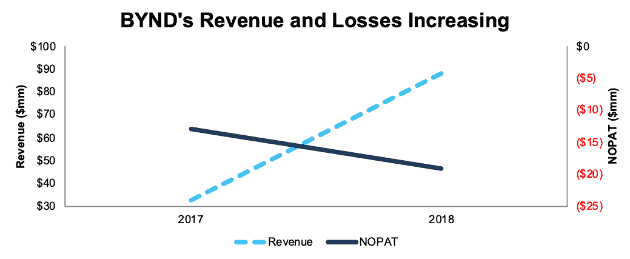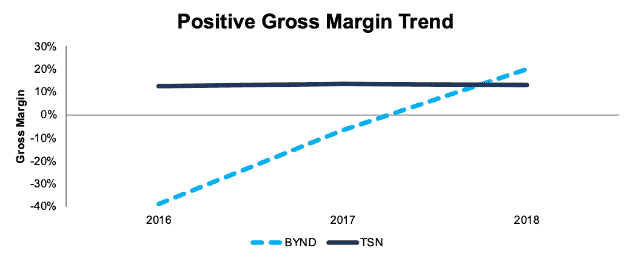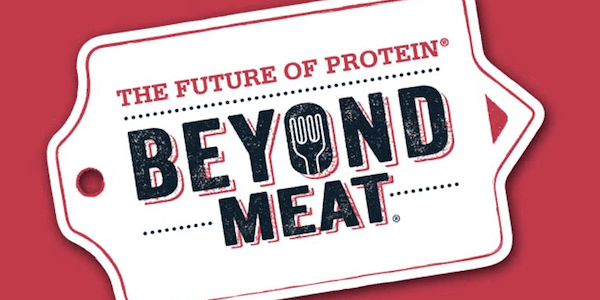Beyond Meat (BYND: $20/share midpoint of IPO price range), provider of plant-based meat alternatives, is expected to IPO on Thursday, May 2. After initially announcing a price range of $19-$21 per share, the company raised its price range to $23-$25 per share and announced it would sell ~1 million more shares. At the current price range the company plans to sell up to $240 million of shares with an expected market cap of ~$1.4 billion. At the midpoint of the IPO price range, BYND currently earns our Very Unattractive rating.
More than any of the other recent IPOs we’ve covered, BYND looks to be a highly speculative investment. The company’s market cap looks unrealistic based on its $88 million in annual revenue and mounting losses. On the flip side, the opportunity could be large, given the $1.4 trillion size of the global meat industry and the $22 billion market cap of major meat producer Tyson Foods (TSN).
This report aims to help investors sort through Beyond Meat’s financial filings to understand the fundamentals and valuation of this IPO.
Losses Are Growing
Beyond Meat was founded in 2009 with the goal of developing plant-based products that would, in the words of its S-1, “look, cook, and taste” like meat. The company uses pea proteins that are processed, woven, and combined with various flavorings to produce a variety of meat substitutes.
While BYND produces a variety of products, it is best known for the Beyond Burger, which is sold in ~15,000 grocery stores and ~12,000 restaurants, including Carl’s Jr., TGI Fridays, and BurgerFi. Overall, BYND earns 58% of its revenue from grocery stores and other retail channels and 42% from restaurant and foodservice customers.
The widespread availability of the Beyond Burger is impressive considering that the product was only launched in July of 2016. BYND is growing rapidly, with revenue increasing by 170% from 2017 to 2018. However, as Figure 1 shows, that revenue growth has been accompanied by rising losses. Net operating loss after tax (NOPAT) increased from $13 million in 2017 to $19 million in 2018, a 48% increase.
Figure 1: BYND Revenue and NOPAT: 2017-2018

Sources: New Constructs, LLC and company filings
BYND may be growing rapidly, but that growth is coming at a high cost.
Evidence of Economies of Scale
The good news for BYND is that, while the company is still relatively small, it’s already showing signs of achieving economies of scale. Gross margins turned positive for the first time in 2018. More impressively, at 20%, its gross margins have already surpassed Tyson Foods (TSN), the largest meat producer in the U.S.
Figure 2: BYND vs. TSN Gross Margins: 2016-2018

Sources: New Constructs, LLC and company filings
The positive gross margin trend shows no sign of letting up either. BYND has tripled its production capacity over the past year, and while it doesn’t have audited Q1 numbers yet, it estimates that its investment in production led to gross margins of 25-26% in the first quarter of 2019.
BYND’s high and rising gross margins raise the possibility that it could become an even more profitable business than existing meat producers if and when consumers accepts its meat substitute en masse.
How Big is BYND’s Market?
Like many recent IPOs, BYND’s grand ambition is to disrupt and take over a massive industry. Rather than marketing itself as a niche product for vegans and vegetarians, BYND wants to compete directly in the meat industry, which it estimates at $270 billion in the U.S. and $1.4 trillion globally.
To this end, BYND has made a point to market its products as meat rather than as a vegetarian alternative. Its products are sold in the meat section of grocery stores, and it has long resisted the labelling of its products as “veggie burgers”.
This strategy of marketing their products towards meat eaters appears to be working so far. The company claims in its S-1 that 93% of customers that bought a Beyond Burger at Kroger in the first half of 2018 also purchased animal meat products during that timeframe.
However, there are still major question marks as to how large the potential market for plant-based meat products really is. Several states are considering adding labelling rules that would restrict BYND and other companies from marketing their products as meat if they don’t contain any animal products. These rules would make it much harder for BYND to make inroads among meat eaters.
The biggest question facing BYND over the next few years is whether its products will gain mainstream acceptance as a form of meat, or if they will always be treated as a niche, alternative product.
Competition is Increasing
While BYND is the largest company in its category, it faces serious competition from both smaller startups and traditional meat producers.
Most notably, Impossible Foods made headlines recently with the news that Burger King will launch the “Impossible Whopper” nationwide by the end of this year. With 7,300 locations nationwide, Burger King will be the largest restaurant chain to sell a plant-based burger.
In addition, Tyson Foods is working on its own plant-based meat products. TSN also recently sold its 6.5% stake in BYND, indicating that it plans to compete with BYND rather than partner with it. If TSN successfully develops a product with comparable taste/texture to the Beyond Burger, its superior scale and distribution channels should give it a significant advantage.
Public Shareholders Have Rights
Encouragingly, BYND will actually allow public shareholders to exercise a role in corporate governance. The company is bucking the recent trend and going public with a single class of common stock, meaning all shareholders will have the same voting rights.
High Expectations, But Still Potential for Upside
Our reverse discounted cash flow (DCF) model shows the expectations implied by BYND’s IPO price are high, but achievable.
In order to justify the high point of its IPO range, $25/share, BYND must grow revenue by 43% compounded annually for 10 years and achieve NOPAT margins of 6%, which would be equal to TSN. See the math behind this dynamic DCF scenario.
In this scenario, BYND would earn $3 billion in revenue in 2028, just 1% of annual U.S. meat industry sales, and just 8% of TSN’s 2018 revenue. 40% annual revenue growth is ambitious, but it’s by no means impossible, especially considering BYND grew revenue by ~300% year-over-year in Q1 2019.
As noted above, there’s reason to believe that BYND may be a higher margin business than TSN as well. If we assume BYND can grow revenue at a slightly faster rate – 45% annually rather than 40% for 10 years – and achieve 8% NOPAT margins, the stock is worth $41/share today, a 64% upside to the high point of the IPO range. See the math behind this dynamic DCF scenario.
Of course, there’s also a potential scenario where BYND’s products fail to gain mainstream acceptance, get squeezed out by their competition, and never turn a profit. Ultimately, investing in BYND is a high-risk, high-reward proposition.
Critical Details Found in Financial Filings by Our Robo-Analyst Technology
As investors focus more on fundamental research, research automation technology is needed to analyze all the critical financial details in financial filings. Below are specifics on the adjustments[1] we make based on Robo-Analyst[2] findings in Beyond Meat’s S-1:
Income Statement: we made $11 million of adjustments, with a net effect of removing $11 million in non-operating expense (13% of revenue). You can see all the adjustments made to BYND’s income statement here.
Balance Sheet: we made $34 million of adjustments to calculate invested capital with a net decrease of $18 million. You can see all the adjustments made to BYND’s balance sheet here.
Valuation: we made $96 million of adjustments with a net effect of decreasing shareholder value by $96 million. Our largest adjustment is $61 million (5% of market cap) in employee stock option liabilities. You can see all the adjustments made to BYND’s valuation here.
This article originally published on April 30, 2019.
Disclosure: David Trainer, Kyle Guske II, and Sam McBride receive no compensation to write about any specific stock, style, or theme.
Follow us on Twitter, Facebook, LinkedIn, and StockTwits for real-time alerts on all our research.
[1] This paper compares our analytics on a mega cap company to other major providers. The Appendix details exactly how we stack up.
[2] Harvard Business School Features the powerful impact of research automation in the case study New Constructs: Disrupting Fundamental Analysis with Robo-Analysts.
